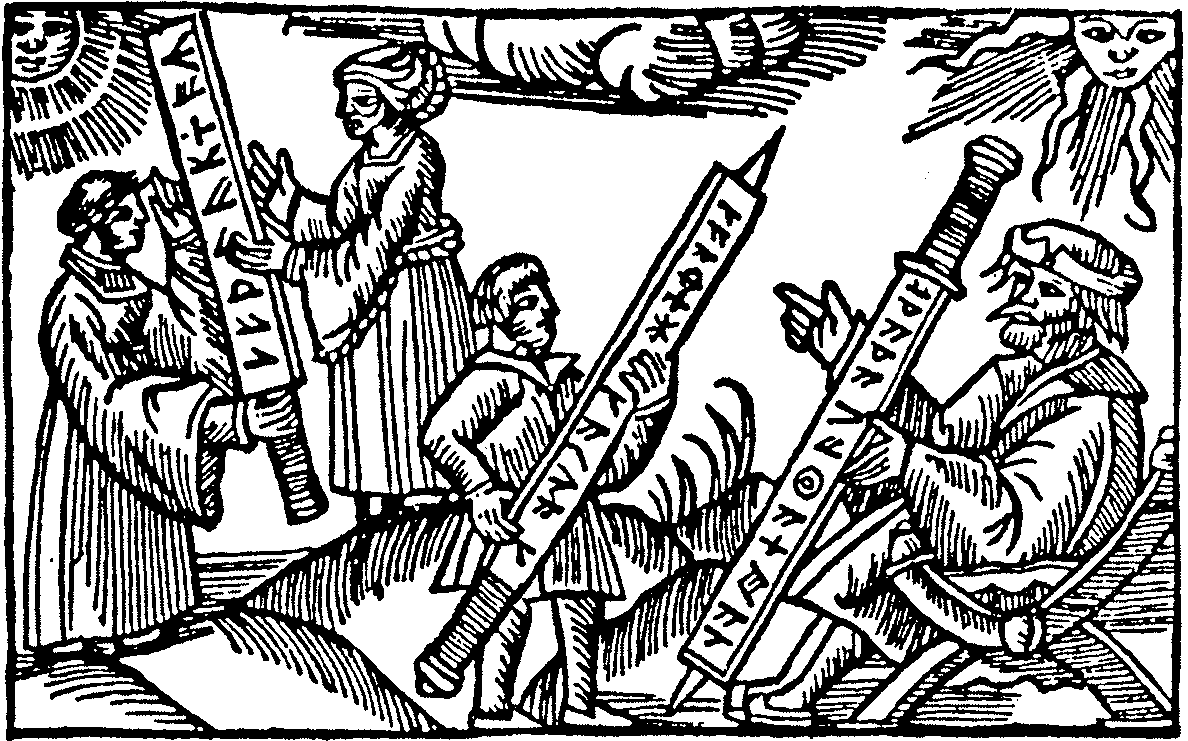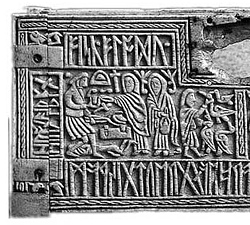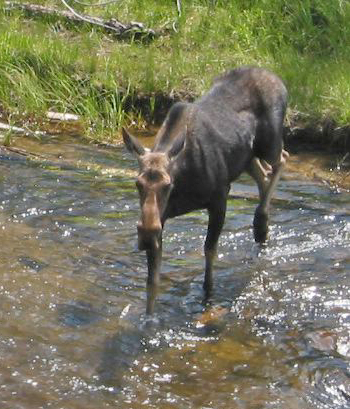|
ßø”
Algiz (also Elhaz) is the name conventionally given to the "''z''-rune" of the Elder Futhark runic alphabet. Its transliteration is ''z'', understood as a phoneme of the Proto-Germanic language, the terminal ''*z'' continuing Proto-Indo-European language, Proto-Indo-European terminal ''*s'' via Verner's law. It is one of two runes which express a phoneme that does not occur word-initially, and thus could not be named Acrophony, acrophonically, the other being the ''┼ŗ''-rune Ingwaz rune, Ingwaz . As the terminal ''*-z'' phoneme marks the nominative singular suffix of masculine nouns, the rune occurs comparatively frequently in Elder Futhark inscriptions, early epigraphy. Because this specific phoneme was lost at an early time, the Elder Futhark rune underwent changes in the medieval runic alphabets. In the Anglo-Saxon runes, Anglo-Saxon futhorc it retained its shape, but became otiose as it ceased to represent any sound in an Old English. However, possibly due to runic manuscr ... [...More Info...] [...Related Items...] OR: [Wikipedia] [Google] [Baidu] |
Ur (rune)
Ur is the recorded name for the Runes, rune in both Old English and Old Norse, found as the second rune in all futharks (runic alphabets starting with F, U, ├×, ─ä, R, K), i.e. the Elder Futhark, Germanic Elder Futhark, the Anglo-Saxon runes, Anglo-Frisian Futhark and the Younger Futhark, Norse Younger Futhark, with continued use in the later medieval runes, early modern runes and Dalecarlian runes. It corresponds to the letter u in the Latin alphabet, but also carries other sound values, especially in Younger Futhark, were its sound values correspond to the vowels: , , and etc., and the consonants: and etc., in the Latin alphabet. Character The character ßÜó may have been derived from the Old Italic scripts, as such features various characters corresponding to Elder Futhark, elder runes, including both upside and downside characters for Upsilon (/u, y/): , , specifically the Rhaetic, East Rhaetic alphabet from the Magr├©-region of north-east Italy, which primarily used t ... [...More Info...] [...Related Items...] OR: [Wikipedia] [Google] [Baidu] |
Medieval Runes
The medieval runes, or the futhork, was a Scandinavian runic alphabet that evolved from the Younger Futhark after the introduction of ''stung'' (or ''dotted'') runes at the end of the Viking Age. These stung runes were regular runes with the addition of either a dot diacritic or bar diacritic to indicate that the rune stood for one of its secondary sounds (so an i rune could become an e rune or a j rune when stung). The medieval futhork was fully formed in the early 13th century. Due to the expansion of its character inventory, it was essentially possible to have each character in an inscription correspond to only one phoneme, something which was virtually impossible in Younger Futhark with its small inventory of 16 runes.Enoksen 1998:137 Medieval runes were in use throughout Scandinavia during the Middle Ages, and provided the basis for runology beginning in the 16th century. History Towards the end of the 11th century, the runic alphabet met competition from the introduced La ... [...More Info...] [...Related Items...] OR: [Wikipedia] [Google] [Baidu] |
Yr Rune
{{disambiguation ...
Yr rune may be: * , a historical rune of the Younger Futhark, see Yr rune (Younger Futhark) * , a variant of the ''u'' rune to express the Old English phoneme in Anglo-Saxon runic manuscript tradition, see Ur (rune) *a rune in the Armanen Futharkh of Guido von List *a rune in the rune row of Karl Maria Wiligut Karl Maria Wiligut (alias Weisthor, Jarl Widar, Lobesam; 10 December 1866 ŌĆō 3 January 1946) was an Austrian V├Člkisch occultist and soldier. He served in the Austro-Hungarian Army during World War I and was a leading figure in the Irminis ... [...More Info...] [...Related Items...] OR: [Wikipedia] [Google] [Baidu] |
Elder Futhark Inscriptions
An elder is someone with a degree of seniority or authority. Elder or elders may refer to: Positions Administrative * Elder (administrative title), a position of authority Cultural * North American Indigenous elder, a person who has and transmits cultural and philosophical knowledge ** Haudenosaunee Clan Mother * Australian Aboriginal elder, one who has gained recognition as a custodian of knowledge and lore, often a leader in administrative matters Religious * "The Elder", author of the Johannine epistles 2 John and 3 John in the New Testament * Elder (Christianity), a person valued for their wisdom and, in some churches and denominations, holding an administrative or oversight role ** Elder (Methodist), an ordained minister with responsibilities to preach and teach ** Elder (Anglican), a learned minister with responsibilities to teach and/or innovate ** Elder (Latter Day Saints), a priesthood office in the Melchizedek priesthood * Thero or Elder, an honorific ter ... [...More Info...] [...Related Items...] OR: [Wikipedia] [Google] [Baidu] |
Anglo-Saxon Runes
Anglo-Saxon runes or Anglo-Frisian runes are runes that were used by the Anglo-Saxons and Medieval Frisians (collectively called Anglo-Frisians) as an alphabet in their native writing system, recording both Old English and Old Frisian (, ßÜ▒ßÜóßÜŠßܬ, "rune"). Today, the characters are known collectively as the futhorc (ßÜĀßÜóßÜ”ßÜ®ßÜ▒ßÜ│, ''fu├Šorc'') from the sound values of the first six runes. The futhorc was a development from the older Germanic peoples, co-Germanic 24-character runic alphabet, known today as Elder Futhark, expanding to 28 characters in its older form and up to 34 characters in its younger form. In contemporary Scandinavia, the Elder Futhark developed into a shorter 16-character alphabet, today simply called Younger Futhark. Use of the Anglo-Frisian runes is likely to have started in the 5th century onward and they continued to see use into the High Middle Ages. They were later accompanied and eventually overtaken by the Old English Latin alphabet introdu ... [...More Info...] [...Related Items...] OR: [Wikipedia] [Google] [Baidu] |
Proto-Norse Language
Proto-Norse (also called Ancient Nordic; Danish and ; ; ; ) was an Indo-European language spoken in Scandinavia that is thought to have evolved as a northern dialect of Proto-Germanic in the first centuries CE. It is the earliest stage of a characteristically North Germanic language, and the language attested in the oldest Scandinavian Elder Futhark inscriptions, spoken from around the 2nd to the 8th centuries CE (corresponding to the late Roman Iron Age and the Germanic Iron Age). It evolved into the dialects of Old Norse at the beginning of the Viking Age around 800 CE, which later themselves evolved into the modern North Germanic languages ( Faroese, Icelandic, the Continental Scandinavian languages, and their dialects). Phonology Proto-Norse phonology probably did not differ substantially from that of Proto-Germanic. Although the phonetic realisation of several phonemes had probably changed over time, the overall system of phonemes and their distribution remained la ... [...More Info...] [...Related Items...] OR: [Wikipedia] [Google] [Baidu] |
Old Norse
Old Norse, also referred to as Old Nordic or Old Scandinavian, was a stage of development of North Germanic languages, North Germanic dialects before their final divergence into separate Nordic languages. Old Norse was spoken by inhabitants of Scandinavia and their Viking expansion, overseas settlements and chronologically coincides with the Viking Age, the Christianization of Scandinavia, and the consolidation of Scandinavian kingdoms from about the 8th to the 15th centuries. The Proto-Norse language developed into Old Norse by the 8th century, and Old Norse began to develop into the modern North Germanic languages in the mid- to late 14th century, ending the language phase known as Old Norse. These dates, however, are not precise, since written Old Norse is found well into the 15th century. Old Norse was divided into three dialects: Old West Norse (Old West Nordic, often referred to as ''Old Norse''), Old East Norse (Old East Nordic), and Old Gutnish. Old West Norse and O ... [...More Info...] [...Related Items...] OR: [Wikipedia] [Google] [Baidu] |
Retroflex Approximant
The voiced retroflex approximant is a type of consonant used in some languages. The symbol in the International Phonetic Alphabet that represents this sound is , and the equivalent X-SAMPA symbol is r\`. The IPA symbol is a turned lowercase letter ''r'' with a rightward hook protruding from the lower right of the letter. The velar bunched approximant found in some varieties of Dutch language, Dutch and American English sounds similar to the retroflex approximant but it has a very different articulation. Features ] Features of the voiced retroflex approximant: Occurrence See also * Alveolar approximant * Retroflex consonant * R-colored vowel * Index of phonetics articles Notes References * * * * External links * {{LetterR Retroflex consonants Pulmonic consonants Oral consonants Central consonants ... [...More Info...] [...Related Items...] OR: [Wikipedia] [Google] [Baidu] |
Moose
The moose (: 'moose'; used in North America) or elk (: 'elk' or 'elks'; used in Eurasia) (''Alces alces'') is the world's tallest, largest and heaviest extant species of deer and the only species in the genus ''Alces''. It is also the tallest, and the second-largest, land animal in North America, falling short only to the American bison in body mass. Most adult male moose have broad, palmate ("open-hand shaped") antlers; other members of the deer family have pointed antlers with a dendritic ("twig-like") configuration. Moose inhabit the circumpolar boreal forests or temperate broadleaf and mixed forests of the Northern Hemisphere, thriving in cooler, temperate areas as well as subarctic climates. Hunting shaped the relationship between moose and humans, both in Eurasia and North America. Prior to the colonial era (around 1600ŌĆō1700 CE), moose were one of many valuable sources of sustenance for certain tribal groups and First Nations. Hunting and habitat loss hav ... [...More Info...] [...Related Items...] OR: [Wikipedia] [Google] [Baidu] |
Old Italic Alphabets
The Old Italic scripts are a family of ancient writing systems used in the Italian Peninsula between about 700 and 100 BC, for various languages spoken in that time and place. The most notable member is the Etruscan alphabet, which was the immediate ancestor of the Latin alphabet used by more than 100 languages today, including English. The runic alphabets used in Northern Europe are believed to have been separately derived from one of these alphabets by the 2nd century AD. Origins The Old Italic alphabets ultimately derive from the Phoenician alphabet, but the general consensus is that the Etruscan alphabet was imported from the Euboean Greek colonies of Cumae and Ischia (Pitheko┼½sai) situated in the Gulf of Naples in the 8th century BC; this Euboean alphabet is also called 'Cumaean' (after Cumae), or 'Chalcidian' (after its metropolis Chalcis). The Cumaean hypothesis is supported by the 1957ŌĆō58 excavations of Veii by the British School at Rome, which found pie ... [...More Info...] [...Related Items...] OR: [Wikipedia] [Google] [Baidu] |
Ingwaz Rune
Old Norse Yngvi , Old High German Ing/Ingwi and Old English Ing are names that relate to a theonym which appears to have been the older name for the god Freyr. Proto-Germanic Ingwaz was the legendary ancestor of the Ingaevones, or more accurately ''Ingvaeones'', and is also the reconstructed name of the Elder Futhark rune ßø£ and Anglo-Saxon rune ßøØ, representing '' ┼ŗ''. Etymology Old Norse ''Yngvi'' as well as Old High German ''Inguin'' and Old English ''IngŲ┐ine'' are all derived from the Proto-Germanic *Ingwaz. Sound changes in late-Proto-Germanic transformed *Ingwaz into *Ingwi(z) in the nominative case and *''Ingwin'' in the accusative case. His epithet * Fraujaz appears in Old Norse compounds ''Ingvifreyr'' and ''Ingunarfreyr''. In Beowulf we see Hrothgar called (OE) ''fr├®a inguina'', which means 'Lord of the Inguins', i.e. lord of the Ingvaeones, the 'friends of Ing'. This strongly indicates that the two deities, Ing and Freyr are indeed the same. However, it is also ... [...More Info...] [...Related Items...] OR: [Wikipedia] [Google] [Baidu] |



